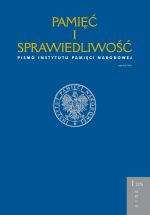Alternatywy dla katolicyzmu politycznego na Węgrzech po 1945 roku na przykładzie Józsefa Mindszentyego i Gyuli Szekfű
The Alternatives to the Political Catholicism in Hungary after 1945 on the Example of József Mindszenty and Gyula Szekfű
Author(s): Pál HatosSubject(s): History, Social history, Recent History (1900 till today)
Published by: Instytut Pamięci Narodowej
Keywords: Communist régime; Hungary; Catholic Church; József Mindszenty; Gyula Szekfű
Summary/Abstract: 1945 was a watershed year for Hungary and Hungarian Catholicism alike. The Ancient Regime of the interwar period has totally collapsed in the wake of the crushing defeat that the humiliated country the shameful last ally of the Nazi Reich suffered from the ‘liberating’ Soviet troops. The Liberation soon to be proved nothing else but a ruthless and full scale occupation and Soviets’ proxies, the Communists gradually took control over the whole political and social system of the country. The Catholic Churches lost not just her centuries old privileged status but also her entire wealth in the wake of the 1945 land reform initiated by the Communist Party. But it remained a powerful social force capable to articulate the voice of millions of faithful for the years to come. Amidst the epochal changes two different strategies were articulated by Catholic clery and the laymen intelligentsia: 1) that of the resistance moral and uncompromising standoff represented by the newly appointed Cardinal József Mindszenty (1892–1975), Archbishop of Esztergom and most of the clergy and 2) that of a rather hopeless ralliement with Christian Democratic overtones which was expressed by the first ambassador of Hungary to the Soviet Union the Catholic historian and influential public intellectual of the interwar period Gyula Szekfű (1883–1955).The historical controverse over the oeuvre of Mindszenty reaches back to his time as active head of the Hungarian Catholics in the late 1940s, continued to be unabated throughout of the Détente and Ostpolitik years in the 1960s and 1970s, and revived vigourously after 1990 when Mindszenty’ s name and fate ceased to be an untouchable political taboo. Mindszenty undertook a very active public life right from the beginning of his carrier and his arrest at Christmas 1948 followed by an internationally echoed show trial that ended with a life sentence made him once for all an emblematic and at the same time a highly controversial figure of the Hungarian Catholic Church. His memory is still bears this original divide. His partisans praise Mindszenty because of infatigable his brave and uncompromising anti-communism and his passionate vision of Catholicism blended with Hungarian national identity, and since his tragic fate symbolises with strength the sufferings of the ‘silent church’ beyond the Iron Curtain. But he is vehemently contested because of his political ambitions, because of his his well–known royalist symphaties and Habsburg affinities even after 1945, because of his emphasis on Hungary as Regnum Marianum implies an exclusivist catholic nationalism and last but not least since his intrasignance did not take account of the needs of the ordinary and feeble beliver not ready for martyrdom. This was indeed the forceful argument for the persons of the compromise like Gyula Szekfű who feared a large scale secularization of the masses under duress lest the Church accepts the new status quo dictated by the Communist régime. The paper explores these alternatives and try to asses the inherent contradictions in both with a view of the symbolical importance of the oppression of the Church for future generations.
Journal: Pamięć i Sprawiedliwość.
- Issue Year: 25/2015
- Issue No: 1
- Page Range: 185-198
- Page Count: 14
- Language: Polish

